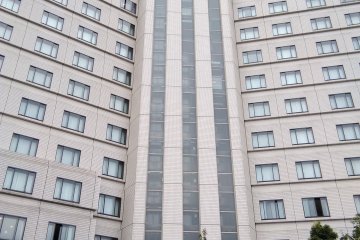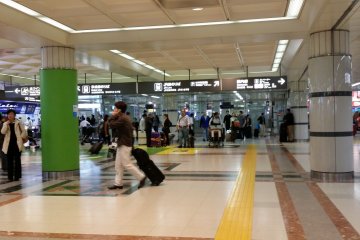Less than an hour from the airport to step back in time to the world of the Edo period (1603 to 1868). From Narita, a short trip brings you to the waterways of Sawara and the castle streets of Sakura, where Edo Japan remains remarkably intact. Both towns are relatively uncrowded, allowing visitors to enjoy a relaxed, leisurely trip. At the end of the trip, Art Hotel Narita welcomes you with open-air baths and the kind of traditional rich-flavored meals that make you linger a little longer.
Step beyond the bustle of the airport and embark on a crowd-free journey to discover some of the best things to do near Narita Airport and explore the hidden depth of Chiba’s history and culture—known only to those in the know.
Sawara, A Town Shaped by Water

Only about 30 minutes from Narita Station, Sawara Edo Town, is often fondly called “Little Edo” for its well-preserved canals and merchant houses that date back hundreds of years. Along the Ono River, traditional boats still drift past rows of wooden storehouses, their reflections rippling gently in the water. The Koedo Sawara Cruise or Boat Tour offers a tranquil 30-minute journey through the heart of this town, with local guides sharing stories of Sawara’s prosperous past as a river trading hub.
If you visit in July or October, you might catch the Sawara Grand Festival, one of Japan’s most celebrated float parades and a registered UNESCO Intangible Cultural Heritage event. Towering festival floats adorned with intricate carvings make their way through narrow streets, accompanied by music and cheers, a vivid reminder that Sawara’s traditions are still very much alive.

Just a short five-minute stroll from the riverside brings you to the Ino Tadataka Memorial Museum, dedicated to Japan’s pioneer of cartography. The museum is located near his former residence, which is also accessible to the public and offers a fascinating glimpse into the life of the man who drafted the country’s first nationwide map with remarkable precision more than two centuries ago. Exhibits in the museum showcase Ino’s painstaking surveying tools, original maps, and personal artifacts.
Sakura, Where Samurai History Endures
Also about 30 minutes by train from Narita Station, Sakura is another town where the Edo period feels close enough to touch. After arriving at JR Sakura Station, it’s approximately 30 minutes on foot to the Sakura Castle Ruins Park, a tranquil expanse where moss-covered stone walls and winding paths trace the outlines of a once-grand fortress. The park is listed among Japan’s Top 100 Castles and is a favorite spot for leisurely walks and seasonal views of cherry blossoms and autumn foliage. If walking the route isn’t ideal, it’s best to take the bus, especially since the road includes an uphill section. The Shirogane NT Line from Keisei-Sakura Station, a loop service, takes roughly seven minutes to Kokuritsu Hakubutsukan Iriguchi (National Museum Entrance), with just a 10-minute walk to reach the park.

Just a short five-minute walk from the park leads you to Bukeyashiki-dori (Samurai Residences). The preserved warrior homes showcase the refined simplicity of Edo-era living—tatami rooms lit by soft daylight, sliding wooden doors, and compact gardens designed for calm reflection. Three of the five original homes remain and are open to the public: the former Kawara, Tajima, and Takei houses.

Continue for another 15 minutes on foot to reach Hiyodorizaka, a gently sloping path lined with tall bamboo. Once trodden by samurai on their way to the castle, it now provides one of Sakura’s most atmospheric scenes. The soft rustle of bamboo leaves and the play of light along the path make it easy to see why it’s a beloved setting for Japanese historical films and dramas.
Naritasan, A Temple Town with Edo-Era Charm


For the next day or before returning to Art Hotel Narita, consider a visit to Naritasan Shinshoji Temple, one of Japan’s most prominent Buddhist temples with a history spanning more than a thousand years. The sprawling complex combines majestic wooden halls with tranquil gardens and ponds. Paths wind past the Main Hall and Three-Story Pagoda toward Naritasan Park, where the 20-meter-high Yuhi Waterfall offers a moment of calm amid the sound of rushing water. It’s an easy place to slow down, breathe, and take in the quiet beauty of Chiba’s spiritual heart.
Just outside the temple grounds, Omotesando Street Naritasan stretches nearly 800 meters toward Narita Station. The lively street is lined with traditional wooden shops, curtain-lined storefronts, and the irresistible scent of freshly grilled unagi (eel), a Narita specialty served in restaurants that have been welcoming travelers for generations. Along the way, you’ll also find crispy rice crackers, the local sweet Kintoki no Amataro-yaki, and the quirky Unagi Bread, a playful nod to the town’s culinary identity. Blending tradition, flavor, and atmosphere, Naritasan and its surrounding streets offer an authentic glimpse of Edo-period charm still alive in modern Narita.
A Pause Between Flights and Journeys at Art Hotel Narita
Art Hotel Narita offers a serene counterpoint to travel’s pace. Chiba has a lot to offer but rest is just as important as the journey, so a Narita hotel near the airport and other surrounding tourist spots is a good option. After drifting through Sawara’s canals, walking along Sakura’s samurai paths, and exploring Naritasan’s temple town, the hotel welcomes you back with quiet rooms, soothing baths, and the promise of a slow morning. Here’s what awaits within:
Relax and Rejuvenate in Biyu Hot Springs

The hotel’s signature attraction, Biyu, draws its natural hot spring water from 1,000 meters underground. The sodium-chloride spring retains heat beautifully, easing tension and restoring balance after a long day of travel. Guests can enjoy open-air and kiln baths surrounded by soft light, or unwind in saunas—regular for men and mist for women.
Experience Dining That Moves with the Day

On the first floor of the main building, the Narita Bold Kitchen turns breakfast into a lively experience. Watch chefs prepare omelets to order or enjoy the restaurant’s signature Morning Ramen, served in three broths, including a light, flavorful soy base. Fresh noodles are cooked right before you and topped with chashu pork, bamboo shoots, and green onions. You can also add a touch of fun and sweetness to your morning with the automatic pancake maker, which produces perfectly golden pancakes at the push of a button—ready for syrup, fruit, or whipped cream. If you prefer a traditional start, the buffet offers a selection of Japanese dishes such as grilled fish, simmered vegetables, and rolled omelets.
As evening falls, enjoy dinner at Japanese and Chinese Restaurant “Soh”, also conveniently situated on the first floor. Choose from full-course meals or a la carte favorites like Sichuan-style mapo tofu and dandan noodles, alongside local specialties. Don’t miss the sweet-and-sour Royal Sangen Pork, made with Chiba’s premium pork, or the restaurant’s original Paiko Noodles, a rich ramen topped with crispy fried pork cutlet.
Rest Easy in Thoughtful Comfort


Despite its proximity to the airport, every room at Art Hotel Narita remains blissfully quiet. Double-glazed windows provide excellent soundproofing, allowing guests to rest in complete peace and comfort.
The hotel offers a diverse range of accommodations to match every traveler’s needs. Standard and Comfort rooms are ideal for solo guests, couples, or business travelers, combining functionality with warmth. Superior rooms add a touch more space and style, while Deluxe rooms are designed for up to four guests, offering panoramic airport views from the upper floors. Some of these rooms offer a tranquil sight of planes gliding across the runways of Narita Airport.
For those seeking a luxurious stay, the Suite rooms on the 11th floor provide generous living areas, refined furnishings, and a calm, modern aesthetic perfect for special occasions. The Garden rooms in the Garden Wing bring a touch of nature indoors with warm wood tones and garden views, while the Family rooms comfortably accommodate up to four guests. The Universal rooms ensure accessibility for any type of traveler, offering thoughtful design and convenience without compromising comfort.
Inside, neutral tones, soft lighting, and carefully arranged spaces create a soothing retreat that balances function and tranquility. Whether you’re arriving, departing, or simply pausing between journeys, every room here invites you to unwind and recharge before the next adventure begins.
Enjoy Facilities Designed for Every Traveler

The sense of calm continues beyond the guest rooms, extending into the hotel’s carefully designed amenities and green spaces. On the second floor of the main building, a 24-hour convenience store and complimentary fitness gym make it easy to stay refreshed at any hour. Step outside to explore the hotel’s Forest Garden, a beautifully landscaped space of over 1,000 square meters that brings a touch of nature to the property. The hotel also offers banquet halls, conference rooms, and wedding facilities, along with parking for up to 430 vehicles, providing comfort and practicality in equal measure.

Art Hotel Narita is easily accessible from Narita International Airport, just 15 minutes away via the Narita Airport shuttle hotel service. The hotel’s convenient location offers both ease of travel and a sense of calm for those arriving or departing. When it’s time to move again, getting around is just as effortless. Free shuttle buses also connect the hotel to JR Narita Station. From the main station, it’s a short journey to the historic towns of Sakura, Sawara, and Naritasan.
Now to get from Tokyo to Narita, the Narita Express (N’EX) provides a fast and direct connection to Narita Airport. Alternatively, you can take the Keisei Skyliner via Ueno Station or the Asakusa Line for a more flexible route to the hotel.
With its balance of accessibility and tranquility, Art Hotel Narita is the perfect base for discovering the harmony of history, nature, and hospitality that defines Chiba and for planning the perfect weekend trip from Tokyo.



















